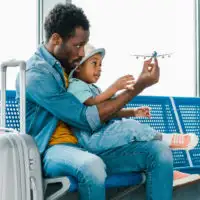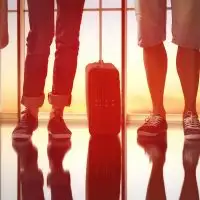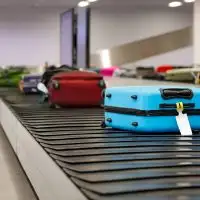You’ve spent countless hours preparing the family for the big day, and it’s finally arrived. You’ve packed wisely (and legally), nixed the layovers, labored over seat assignments and photocopied birth certificates and passports. You’ve chosen a flight to coincide with nap time and invested in the latest travel gadgets, all for the sake of the kids.
You know you can’t plan for everything, but you’ve planned for what you can. Now it’s time to put that plan into motion. These are our best tips for flying with kids.
Tips for Flying With Kids: Before You Go
1. Consider signing up for TSA Precheck. Expedite the security process (and avoid the inevitable stress) by investing in TSA Precheck for either one or both parents or guardians. You might also consider Clear or Global Entry, the latter of which includes TSA Precheck. Not sure which one to choose? Check out this helpful guide to choosing CLEAR, TSA PreCheck or Global Entry.
Tips for Flying With Kids: Airport Arrival
2. Don’t be late. The airlines say it, the FAA says it, but you can never hear it enough, especially when kids are involved: Give yourself plenty of time. How early you need to arrive depends upon a variety of factors, including your airline, airport, plans for parking, flight time and whether or not you’re checking baggage. If you’re traveling during school vacations, the airport will likely be crowded with other families doing the same thing. We recommend arriving at least 90 minutes ahead of your scheduled departure. Keep in mind that some destinations (such as international flights and the U.S. Virgin Islands) have earlier check-in times than others; if you miss the plane, it can be very difficult for you to find enough seats or seats together on a later flight.
3. Know the location and workings of long-term parking. Long-term parking is the most economical place to leave your car, but it’s also the least convenient. Several years ago, when flying out of JFK alone with my son, it took me a solid hour to get from long-term parking to my terminal. It was raining, and I had a stroller and bags to be checked. I was ready to go home before I even stepped foot in the airport. In most cases, you’ll need to take a bus, tram or train to the terminal from long-term parking lots; be sure you know the schedule before you get there and how you’re going to handle all of your stuff (and kids).
4. Get a ride to the airport. If you can, get a ride to the airport so you don’t have to worry about parking and can be dropped off at the curb. We highly recommend asking a family member or friend for a ride to the airport. If they don’t have room in their car, offer to let them use yours. If you can’t catch a ride and you can afford it, consider hiring a car service or scheduled an Uber or Lyft. If you need to drive and have two adults, have one parent dropped off at the curb with the kids and the luggage while the other parks the car.
Tips for Flying With Kids: Checking In
5. When possible, check in online from home.
Take advantage of online check-in, and either print your boarding passes ahead of time or save them to your phone. It will save you aggravation and time at the airport. More importantly, getting seat assignments near one another is imperative when traveling in a group (especially on full or sold-out flights) and unfortunately, your seats won’t necessarily be together, even if you book them together. Use these tactics to ensure your family can sit together on the flight.
6. Consider your seat choices.
If you’re traveling with an infant, consider asking for a seat in the back of the plane. If there are any empty seats left on the flight, chances are they will be in the back, and you might have extra room to stretch out. In addition, you are closer to the bathrooms, will have extra standing space and will have flight attendants close at hand if you need them. Bulkhead seats have a little extra leg room, and remember that you’ll need to avoid exit-row seats with kids.
7. Carry on only what you need.
Presumably, you’ve done this at home, but go over the bags before you check anything. When you’ve got children, the ratio of carried to checked items is a careful balancing act. Even though it may feel like you need to pack half the house in your carry-on, be realistic about what you really need with you on the plane. Being bogged down by loads of unnecessary weight can be as unpleasant as having too little. Try to pack a few surprises for the kids in your carry-on. Go to a discount store or Amazon for a couple of small, inexpensive items like stickers, small toys or action figures for younger kids and music, books or handheld games for older kids. If you can manage it, consider bringing a portable DVD player, Nintendo Switch, or tablet.
Related: The Ultimate Carry-On Bag for Moms
8. Let kids who are old enough to help do so.
Children ages 3 and older should be able to manage their own small carry-on bags through the airport. Something with wheels or a small backpack is ideal. Older kids can also help wheel the checked bags inside. Giving people jobs to do will keep them focused and make your life easier.
Tips for Flying With Kids: Security
9. Talk the kids through this beforehand.
If you don’t fly often, discuss with your children ahead of time what this process will be like and what will be expected of them. Even if you are frequent flyers, remind your children to be on their best behavior. If they see you taking it seriously, they are more apt to do so themselves. It might be helpful to review the FAA’s tips for getting through the screening process as a family.
10. Follow the rules.
Again, you’ll do the real planning for this at home, but double check your items before getting in the security line. You can’t bring liquid or gel that’s more than 3.4 ounces in your carry-on bag. However, if traveling with an infant or toddler, you’re permitted to pack breastmilk, formula, juice and medications in “reasonable” quantities. These liquids are not subject to the three-ounce rule. If you’re traveling with any of these items, you should place them in a separate (second) TSA-approved bag or food storage bag, and remove them from your carry-on prior to going through security. You can also bring snacks in your carry-on luggage. Make sure you haven’t packed any prohibited items in your carry-on. Keep adult boarding passes and IDs handy, as you’ll be asked to present them while passing through security.
11. Know that almost everything must pass through the X-ray machine.
Unless you have TSA PreCheck, all baby gear, including strollers and car seats, will need to be collapsed and put through the X-ray machine; you will need to remove hats, jackets, belts, backpacks and baby carriers. All of your teen’s electronics will need to go through, as well. Children, along with adults, will need to remove their shoes and put them through X-ray, so consider Velcro sneakers or something that’s easy to get on and off—this will be convenient on the plane, too. It may seem like common sense, but avoid packing any children’s toys that even remotely resemble weapons—they will be taken from you. Upon returning from Disney one year, the TSA confiscated my son’s pirate sword.
Related: 11 Best Travel Shoes for Kids
12. Know your kids must also go through the metal detector.
If your child can walk, he or she will likely be asked to pass through the metal detector alone. If not, you may carry your child through with you. If the alarm sounds, you will be inspected together by an agent. No one will separate you from your children.
13. Divide and conquer with little kids.
If there are two adults in your party, it’s often helpful to assign a task to each. My husband is usually in charge of the gear, and I’m in charge of helping the kids—getting shoes and sweatshirts on and off, directing them through the metal detector, and the like.
Tips for Flying With Kids: In the Terminal
14. Don’t just sit there.
Once you’ve made it through what is generally the least pleasant part of the airport experience with kids, you should have some time to kill. Don’t panic or break out the surprise ammunition just yet. (Save those items until you’re trapped on the plane with nowhere to go.) Instead, get creative with airport activities for kids that get them moving while they still can—like a scavenger hunt.
15. Get something to eat.
Airport food courts and restaurants are a great place to waste some time, and they also serve a practical purpose. You won’t be getting anything good on the plane, so feed the kids now. Kid-friendly fare and restaurants are becoming more visible at airports these days, and chains abound. Avoid overly messy or smelly foods, and take any leftovers with you in your carry-on.
16. Inquire about airport play areas.
If your kids are small, see if there is an airport play area where they can burn off some energy. Many airports have them in some form or another, whether they’re funded by the airport itself, an airline or a local sponsor. Philadelphia, Boston and Chicago O’Hare all have great kids’ areas that are sponsored by local children’s museums, and Seattle’s Sea-Tac airport has a cool aviation-themed area, as well as a separate infant room with rocking chairs and a private bathroom.
17. Take advantage of airline lounges.
If you can, absolutely take advantage of airline lounges when traveling with your kids. Once primarily full of business travelers, you now see more families making use of them, so much so that many have even added separate family rooms and amenities. They’re a great place to hang out because they often offer televisions, games, reading material, free snacks, free Wi-Fi and clean bathrooms. Rules and fees vary by club, but you can purchase day passes, as well as annual or lifetime memberships, and, if you are traveling first class or if you’re an elite member of your airline’s frequent flier program, you’re usually entitled to free or discounted admission. Priority Pass is the world’s largest independent airport lounge access program and gets you in to over 900 clubs worldwide for an annual fee starting at $99, while also requiring you to pay $27 per visit. A platinum American Express card will also gain you entrance to many of these at no charge.
18. Take a bathroom break just before boarding.
They’ll inevitably have to go again as soon as you’re seated, but do it anyway. If you have a child who’s potty training, consider switching to a pull-up just before boarding. It’s a personal decision, but remember: you can change their clothes, but they are stuck in that seat (and you are stuck in the one next to them) for the duration of the flight.
Tips for Flying With Kids: Boarding the Plane
19. Be on standby. Make sure you make it back to your gate in time for the first boarding call at least a half-hour ahead of time—but not too long before. Families traveling with young children are allowed to board right after the first-class and elite passengers on select airlines; check out these major family-friendly airlines to see your airline’s policies. Take advantage of this, especially if you’re traveling with a lot of gear. If you’re planning to use a car seat on the plane, it will be much easier to install before the rush of passengers, and flight attendants will be more apt to give you a hand if you need it. If you’re traveling with a stroller, you’ll leave it just as you’re stepping on to the plane, and will reclaim it as you step off.
Tips for Flying With Kids: On the Plane
20. Give kids time to settle themselves.
Younger kids will be excited and anxious, and curious about everything in their new space. This is the time to let them investigate, while it’s noisy and no one is paying attention to them.
21. Don’t stow too much.
Decide what you should keep at your feet, as opposed to in the overhead bin. Items you’ll need frequently should be kept close at hand, especially if you have a window or middle seat. Chances are, your seat mates will be getting up enough times, just on account of bathroom breaks.
22. Avoid dehydration, and move around.
While in the air, especially if it’s a longer flight, be sure to keep the kids hydrated, and encourage them to get up at least once and walk up and down the aisle. This will pay off later, as they’ll feel better when you land. Water is the best choice for a drink; drinks with caffeine should be avoided.
23. Teach children about equalizing.
Explain to your kids what to do if their ears are hurting or if they are having trouble hearing. If you think children are having difficulty equalizing their ears, have them take a small drink or give babies a bottle. Older kids can suck lollipops or chew gum.
24. Ask about free stuff.
Although increasingly rare, kids’ airplane activity packs do still exist, and there’s no harm in asking about them. Anything new is bound to be cooler than something you brought along.
25. Break out some surprises.
You’ll know when you need to resort to this. When the kids start to get antsy, surprise them with that new Nintendo DS game or special treat.
26. Talk to your children.
It sounds silly, but seriously, how often do you get the chance to spend this much uninterrupted time with your kids? Take advantage of the time together, and do your best to get older kids to get off of their devices for a few minutes and talk about what they’re looking forward to most about the trip. With younger kids, pull them close and make up a story together.
27. Dismiss grouchy passengers, and be proud of your kids.
Let’s face it: On every flight, there will be a few people who, no matter how well your children do, are inherently grumpy or just don’t like kids. They’ll grumble under their breath when your child drops something or turn around and sneer when voices get too loud. But really, who cares? You’ll never see them again after the flight, so return any sneers with a smile, and be proud of your kids. They have as much of a right to be there as anyone else.
Our team of parents and travel experts chooses each product and service we recommend. Anything you purchase through links on our site may earn us a commission.







